 |
|---|
| Messier 64 (M64) has a spectacular dark band of absorbing dust in front of a bright nucleus, giving rise to its nicknames of the "Black Eye" galaxy. |

|
'Black Eye' Galaxy
Reuters
WASHINGTON - The Hubble Space Telescope has snapped a new image of the "Black Eye" galaxy, so named because an ancient cosmic smashup produced a dark ring and a roiling, conflicted interior. What looks like a black eye in the Hubble picture is actually a dark band of dust that stands out vividly in front of the galaxy's bright nucleus, Hubble scientists said in a statement on Thursday. The galaxy is officially known as Messier 64 (M64). In some earlier images, the "Black Eye" appears to be a fairly normal spiral galaxy. And as happens in most galaxies, all the stars in M64 are rotating in the same direction. But detailed studies in the 1990s found that while all the stars are heading the same way, interstellar gas at the outer reaches of the galaxy is rotating in the opposite direction. At the point where the stars and gas shear against each other, the gases collide and get smashed together, creating a region of active star formation, the scientists said. The new image shows an area where hot blue stars have just formed, along with pink clouds of hydrogen gas that glow when exposed to ultraviolet light from the infant stars. Astronomers believe M64's internal conflict arose when the "Black Eye" absorbed a satellite galaxy that collided with it, perhaps more than a billion years ago. Most visible traces of this smaller galaxy have been obliterated, but signs of the collision persist in the backward motion of the outer edge of M64. Long known to amateur astronomers because it can be seen with small telescopes, the "Black Eye" galaxy is about 17 million light-years from Earth in the constellation Coma Berenices (Berenice's Hair). A light-year is about 6 trillion miles (10 trillion km), the distance light travels in a year.


 Share your thoughts in the Forum
Share your thoughts in the Forum
